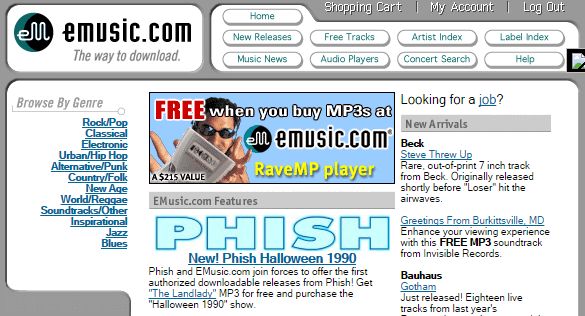Once a pioneer, subscription music-download site eMusic is striking out afresh with news of a change its music catalog. It will focus on indie labels and artists, and the service will discontinue major-label recordings. In doing so, eMusic circles back to its roots as a champion of indie music, and of users who dig deeper than the hit charts.
eMusic started in 1998, and was my first music subscription. The plan then was unlimited: a monthly subscription price unlocked all-you-can-eat MP3 downloads. There was no DRM (digital rights management), a feature/flaw of the iTunes Music Store when it opened five years later. The music inventory was small by today’s standard. I remember endless promotions of They Might Be Giants, which signed on early and released one of its albums exclusively on eMusic. In a late-1990s industry conference I heard a major-label exec scorn eMusic from the stage with this crack: “There’s only so much They Might Be Giants you can listen to.” The audience tittered knowingly.
Though limited, the eMusic catalog was glorious in certain niches — notably folk and classical. The lack of major-label licenses kept eMusic on the fringe, but in its small way it provided an effective antidote to Napster piracy, which was on the rise. Napster’s price tag (um, zero) was obviously appealing to people, but its less-discussed values were its long tail, the break-out of singles from albums, and very fast delivery (even in those low-bandwidth days). eMusic’s all-you-can-eat plan felt free, and the monthly cost bought safety from malware and a clear conscience.
Things changed in 2004 when eMusic altered its business model, establishing limited subscription levels and eliminating the endless feast. The business need was easy to understand, but the effect felt calamitous. After years of sporadic bingeing without watching a meter, the service felt completely different. Not only did the bottleneck severely constrain how much music you could get, but you had to be watching the calendar, too, because unused download credits could not be carried over. (Hello, smartphone plans of the future.)
As eMusic’s value to old-timers dropped, it sought to cast a wider net by bringing mainstream music onto the platform. At the same time, though, streaming music was slowly introducing the “celestial jukebox” concept, wherein entire catalogs were available with a feels-free monthly subscription. Critics derided music subscriptions as “music rental plans” — never mind that most of America was hooked on pricey cable TV. TV hasd never been personally owned, and music had never been accessed via subscription. It took years for that gulf to be meaningfully bridged — and music subscriptions are still marginal.
Today, eMusic’s basic model is subscribe-to-download, an unusual hybrid. The basic plan gives you 24 MP3 downloads for 12 bucks — a good value for downloaders. Honing its market by ditching the majors and re-embracing the indies might be an effective differentiator. But now eMusic is up against a tidal trend from ownership to access, whether that access is represented by lean-forward subscribers or lean-back online radio listeners.
Here is what eMusic will uncover in the next year: Is success about the right catalog, or the right delivery platform?
In the press coverage I’ve seen this morning, Janko Roettgers had the most succinct summary in his very brief GigaOM article: “eMusic currently offers plans starting at $12 for 24 MP3s a month, which sounded like a great deal until … Spotify.”


Big fan of the blog, but I think your pricing is wrong in this article.
Hey Bruce — fan of your work, too. 🙂 Thanks for pointing out the error, which is now corrected. Cheers.
What your article doesn’t mention is that emusic made the change to their catalog, eliminating the vast majority of their offerings, without notice. Customers who preferred the major-label music were left with account balances they couldn’t use. Emusic has a no-refund policy, which they refuse to waive even in cases where they yank a huge product line without warning. They state in their after-the-fact “announcement” that their customers’ plans will not change. How is pulling entire categories of music not a change? Slapping one’s customers in the face is usually a bad business practice and it usually backfires.